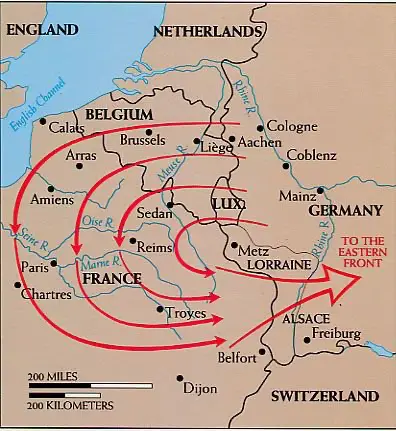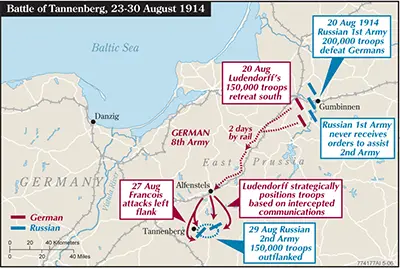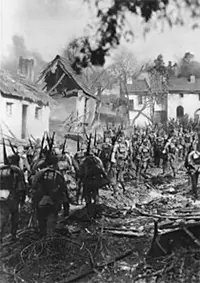The Battle of Tannenberg
The Battle of Tannenberg was a strong German victory over Russia in the early days of World War I. 
The German high command had deployed a modified version of the Schlieffen Plan, which called for a German invasion of neutral Belgium in order to achieve an envelopment of French troops massed at the France-Germany border. The strong belief that even though France and Russia had a mutual defense pact as part of the Triple Entente (the third member of which was the United Kingdom), Russia would not be able to mobilize its forces in time to distract the German invasion of France, which Alfred von Schlieffen had estimated would take only six weeks to achieve. Russian forces deployed much more quickly than anyone else thought, invading East Prussia on Aug. 7, 1914, just a few days after Germany had invaded Belgium. The Russian target was Konigsberg, which was lightly defended. German commanders in the east had orders not to attack Russia until France was defeated; they attacked anyway and ended up retreating. A desperate chief of staff Helmuth von Moltke rushed forces via the newly minted German railroad network from west to east, in the process removing some forces from the force invading France. Russian forces had tasted victory at Gumbinnen, forcing the retreat that so panicked Moltke. Another thing that happened at Gumbinnen was that German troops found, in the possession of a Russian officer killed in the battle, plans for a future Russian offensive. So the German commanders knew where and when to concentrate their forces. 
Commanding the two Russian armies were two men who detested each other and vowed not to work together. Russian forces at this battle also suffered from insufficient amounts of ammunition and transport capabilities. Moreover, even though the Russian force outnumbered the German force by more than 2-to-1, the German army was well trained and experienced and neither of those things could be said of the Russian armies. Commanding the German army was Paul von Hindenburg. The battle began on August 26; four days later, it was finished. Hindenburg sent one set of troops directly at the Russian force and also sent another group via rail to flank the Russians on the left. The encirclement was successful, and the Russian force surrendered. (The Russian commanders' personal enmity had played in the defeat, as the 1st Army commander, Gen. Paul von Rennenkampf, for a time refused to send in reinforcements to Gen. Alexander Samsonov and the 2nd Army, who were being encircled.) 
The German forces captured hundreds of heavy Russian guns while also inflicting heavy casualties on the Russian force: Estimates are about 50,000 dead or injured and about 90,000 captured. German losses were 1,800 dead, 7,500 injured, and 4,700 missing. The battle took place 19 miles from Tannenberg, but Germany named it the Battle of Tannenberg anyway, partly as a way to help ease the still lingering pain of the defeat of the Teutonic Knights at the hands of a Polish force in the same place in 1410. |
|
Social Studies for Kids
copyright 2002–2024
David White




